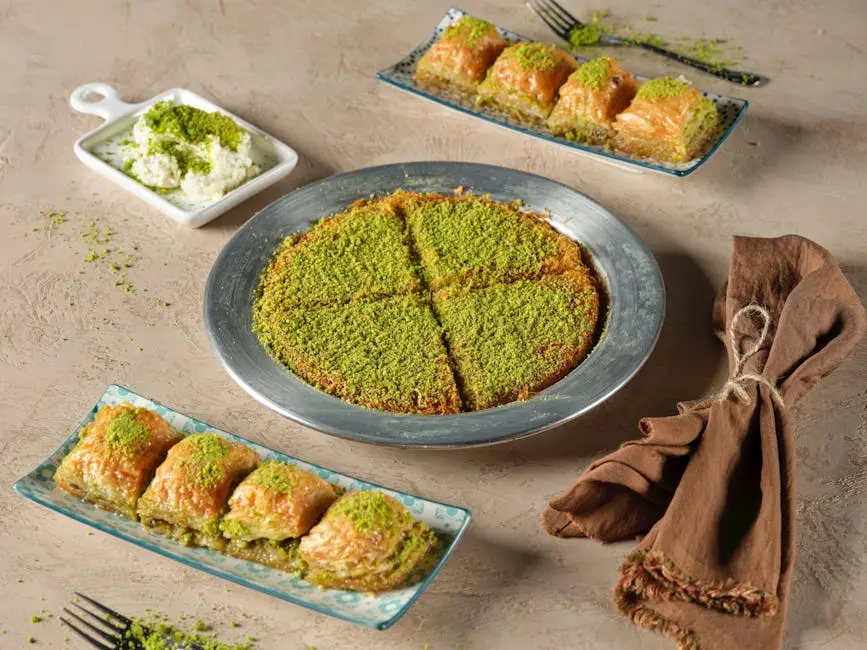
Middle Eastern Desserts: A Taste of History and Culture
Middle Eastern desserts are not just sweet treats; they are a delicious blend of history, culture, and art. In this blog, we will explore some of the most beloved desserts from the region, their origins, and what makes them so special. Whether you have enjoyed these delectable bites before or are trying them for the first time, come along to discover the rich cultural tapestry behind these iconic sweets.
The Origins of Middle Eastern Desserts
Middle Eastern desserts have roots that stretch back thousands of years. From ancient trade routes to the spread of spices, these sweets have evolved through various cultures and civilizations. The rich tapestry of flavors can be traced back to the times of the Ottoman Empire, where cooks experimented with ingredients and techniques that influenced what we know today.
Historically, sweets in this region were often reserved for special occasions, like weddings and feasts. They were not just desserts but symbols of hospitality and generosity. When guests were welcomed into a home, sharing a dessert was a way to show respect and appreciation.
Interestingly, the use of these confections often transcended borders, leading to a melding of various culinary practices. This cross-cultural exchange enriched the traditional recipes, laying the groundwork for modern interpretations of these age-old desserts.
Popular Ingredients and Their Significance
Common ingredients such as dates, nuts, honey, and spices play a significant role in Middle Eastern desserts. Each ingredient not only adds flavor but also carries cultural meanings and traditions. For instance, dates are often associated with hospitality and are a staple in many households, sometimes served with coffee as a gesture of welcome.
Nuts, particularly pistachios and almonds, are frequently utilized in sweet dishes, symbolizing wealth and abundance in Middle Eastern culture. These ingredients often create textural contrast in desserts, providing that delightful crunch against silky, sweet layers.
Honey, a natural sweetener, has long been revered in the region for its health benefits and exquisite taste. Its incorporation into various desserts highlights the importance of nature’s offerings in Middle Eastern culinary practices. Spices like cinnamon and cardamom elevate the flavors, creating a unique aromatic experience that speaks to the complexities of the region’s history.
Must-Try Middle Eastern Desserts
From baklava to knafeh, there’s a wide variety of desserts to explore. We’ll take a closer look at some of the most iconic treats and what makes each one unique. Baklava, for example, is an exquisite pastry layered with nuts and drenched in honey syrup. Its renowned flaky texture and sweetness have captivated palates for centuries, making it a must-try for any dessert lover.
Knafeh, another beloved dessert, typically features a base of shredded phyllo dough soaked in syrup and filled with gooey cheese. This dish is often served warm and topped with crushed pistachios. It’s both comforting and indulgent, embodying the essence of Middle Eastern sweets.
Other favorites include maamoul, a delicate shortbread cookie often filled with dates or nuts, showcasing the artistry involved in Middle Eastern baking. And let’s not forget about halva, a dense confection made from tahini and sugar, which presents its own fascinating taste sensation. Each of these desserts tells a story, inviting us to connect with the culture they come from.
The Role of Desserts in Middle Eastern Culture
Desserts are more than just sweets in Middle Eastern culture; they are often part of celebrations, gatherings, and family traditions. Discover how these desserts bring people together. For many, a family gathering would feel incomplete without a spread of desserts to share, serving as a central part of the dining experience.
During Ramadan, for instance, it’s common to break fast with a sweet treat, reinforcing the idea of sweetness serving as nourishment for both the body and soul. Desserts become a means of connection, a way to celebrate love and generosity. In weddings, beautifully arranged sweets symbolize the joy of union.
In essence, these desserts are intricately woven into the fabric of life in the Middle East. They act as a medium through which stories are told and bonds are strengthened, serving not just to fill appetites but to forge relationships and relay traditions to the next generation.
How to Make Traditional Middle Eastern Desserts at Home
Want to try your hand at making these treats? We’ll provide you with some simple recipes and tips to help you recreate your favorite Middle Eastern desserts right in your kitchen. Starting with baklava, you’ll need layers of phyllo dough, a mix of crushed nuts, and a rich honey syrup. The technique may take some practice, but the results are undeniably rewarding.
Knafeh is another treat that is surprisingly straightforward to make at home, requiring just a few ingredients and a bit of love. As you prepare it, you’ll notice how the warm, cheesy filling contrasts beautifully with the crispiness of the phyllo. Don’t hesitate to experiment; each person has a unique twist they bring to traditional recipes, which adds to their charm.
And for those who prefer a no-bake treat, making halva can be a fun project. With just tahini, sugar, and your choice of nuts, you can whip up this delicious confection in no time. The satisfaction of preparing these desserts in your own kitchen is immense, promoting a sense of connection to the culture and heritage behind each recipe.
Savoring the Sweetness of History and Culture
Middle Eastern desserts tell a story of tradition, family, and celebration. Each bite is a reminder of the cultural influences that have shaped this region over centuries. So, the next time you indulge in a piece of baklava or sip on a cup of sweet tea with halva, take a moment to appreciate the history and passion that goes into each creation.
